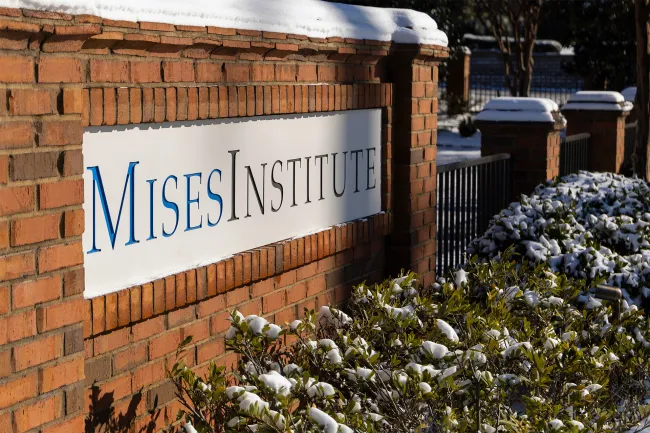MCMAKEN: Following the financial crisis of 2008, there never was any sort of real reckoning for mainstream economists, who had totally failed to see the crisis coming or understand its origins. The Austrian School economists, though, immediately understood the problem. What is different about the Austrian School, and how does it give us a little bit of an edge in understanding things better?
SALERNO: Let me just go back for a moment to the financial crisis. In an interview on The Charlie Rose Show in December of 2005—that was right before the financial crisis began to hit and right before people were seeing a financial bubble, and Austrians were already calling what we had a housing bubble—Milton Friedman, who was a leading empirical economist and a leader of the school that believes that you can create economic theory by testing it against the data, claimed that we were in the most productive and the best period of the American economy in his lifetime. He praised in glowing terms Alan Greenspan, chairman of the Fed at the time.
And here we were on the precipice of the explosion of a housing bubble that was going to turn into a financial crisis two years later. Friedman had no clue that that was the case. But people like Peter Schiff, our own Mark Thornton, and a number of others already in 2003 and 2004 were pointing to the fact that we had a growing housing bubble.
Now, they were able to do that because they understood Austrian economics, which begins with human action and deduces a lot of theorems. Way down this chain of deduction is business cycle theory. Business cycle theory comes out of those theorems that are developed from the human action axiom. So, it’s grounded in reality and it explains reality. If the logic is correct (and it’s not always correct, and people have to go back and check the theorems and so on), then we have real things to say about what’s going on in the real economy.
So the condition for a boom-bust cycle according to Austrian business cycle theory is that there has to be an increase of the money supply that drives down the interest rate below the rate of profit that businesses are earning.
So you’ll have excess borrowing of this newly created money, and that will bring about a disproportion in the production processes: Some will grow more than others, inconsistently with human wants and desires.
MCMAKEN: There seems to be a lot of confusion about what Austrian business cycle theory actually is, though. Paul Krugman for example, throws out all sorts of bizarre theories like the “hangover theory” of recessions, and he’ll accuse Austrians of basing business cycle theory on some sort of moral theory that if you “party” too much, you have to have a recession to correct things afterward. Others claim that the Austrian theory is something simplistic like “What goes up must come down.”
SALERNO: The Austrians don’t say that at all. The Austrian theory states that if you create new money, you’re going to distort the interest rate and mislead entrepreneurs into producing things that are not as urgently demanded by consumers. That is, you’re going to be fooled into thinking that people want to save more for the future, and therefore want to invest more in capital goods today, and that they’re willing to postpone some of their consumption into the future. That’s not “What comes up must come down,” the notion that we splurge too much in investment spontaneously.
No, entrepreneurs generally do not make mistakes. A small minority of them do, and they go out of business. There’s a selective process in which entrepreneurs who are bad—who do not forecast the future accurately—are driven out of business. So why suddenly do we have what Murray Rothbard called a cluster of entrepreneurial errors? Why suddenly do almost all entrepreneurs make mistakes and have their businesses going bankrupt?
That question is not answered by the mainstream, by the Keynesians, by the monetarists, by the neoclassicals, by anybody besides the Austrians. The Austrians explain why entrepreneurs can all be misled at the same time, and that it is something external that distorts their calculations. That external thing is the manipulation of the interest rate by the Fed.
MCMAKEN: That’s an important point, because a lot of the time the explanation for speculation in the marketplace or price inflation is “greed” or “animal spirits,” which are not explained by something external to our mental activity. We’re told there were “animal spirits” that caused us all to be greedy all of a sudden, so a bubble resulted. But the Austrian School doesn’t say this, right?
SALERNO: “Animal spirits” was an infelicitous term—not a very good term—coined by Keynes and applied to businesspeople. It means that business decision makers all become very optimistic—like a horse that’s kind of calm and standing around, and then suddenly he’ll take off and run. That’s “animal spirits.”
Suddenly businesspeople become so optimistic that they’re willing to forget all their calculations and all their experience and invest wildly in projects that that are going to fail. And then, of course, others pick up these spirits and then jump on the bandwagon. That’s nonsense. It’s not an explanation at all. That’s a deus ex machina, that’s the god coming out of the machine and saying, “Okay, this is what caused all that.” The Austrians, on the other hand, have a worked-out explanation for the cause.


